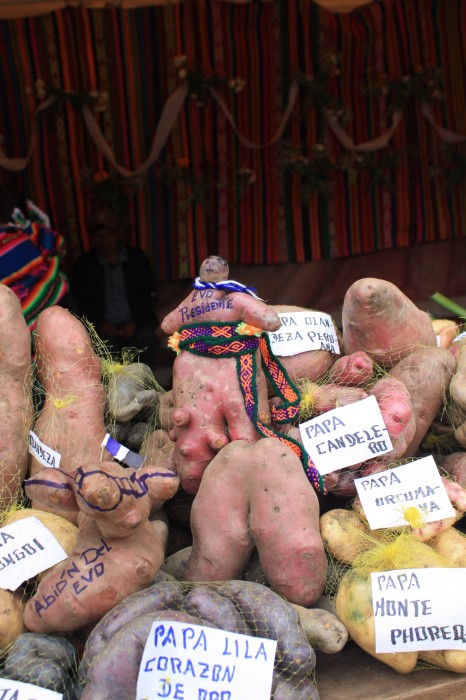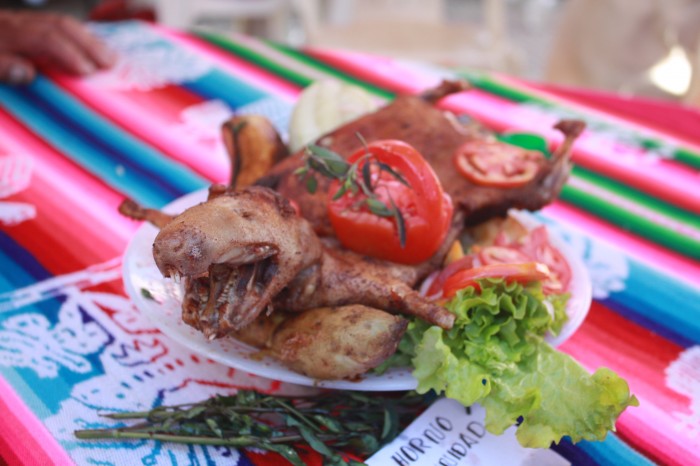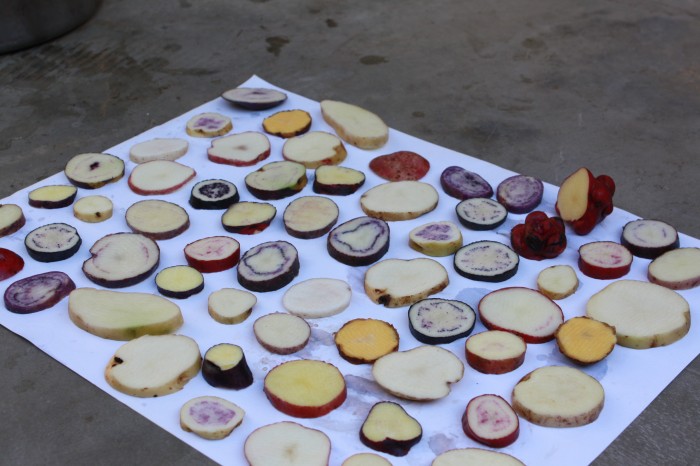In the first farming settlement of the [Andean] cold country I should place emphasis on the second-rate tuber crops—oca, ulluco, and añu … They are inferior in food value and in yield to potatoes, but are maintained in cultivation by highland Indians from Colombia to Peru and are grown in the same fields as potatoes. There are numerous races of each, and all three are man-made species, remote from wild kin. It is difficult to believe that people who had passably satisfactory potatoes to hand would have given attention to transforming such wild plants into root crops which provided nothing that was not better provided by potatoes. On the other hand, if the minor tubers were developed first, they might retain a place in Indian cooking because of traditional dishes and old taste preferences. Wherever there are highland Indian communities these tubers still are much used; white people do not care for them. (Sauer 1969: 50–51)
There are few activities less charismatic than the write-up period of a dissertation. Having returned from my fieldwork in Bolivia a little more than a year ago, my days are currently somewhat fragmented. I read or reread segments of books, I search my field notes for particular experiences, or I spend hours cleaning a handful of survey variables.
But from time to time, like when I stumbled across this opinionated passage by the formidable agricultural geographer Carl Sauer, a thread linking the fragments snaps taut. I went to Bolivia to study precisely the crops that Sauer dismisses. To him they were “second-rate,” but to many contemporary Bolivian farmers, chefs, and agrobiodiversity conservationists, these crops are rare delicacies to be valued and protected.

There are many things about this passage in Sauer that we might question today. For example, we might treat with skepticism the assumption of a simple periodization of cultivar types, wherein primitive people plant minor tubers, like oca and ulluco, and more modern ones plant potatoes. So, too, should his slippage into a simple racial binary dividing “Indian” from “white” raise warning bells for the contemporary reader.
But what interests me about this passage is not only how current anthropological thought would revise it. Rather, I’m drawn to a simpler expression therein: despite his life’s work of cataloging the diversity of American agriculture, Sauer, it seems, had little affinity for Andean foods.
It strikes me as curious that a figure who spent so much of his life understanding and celebrating the diversity of the world’s crops might also so easily dismiss a few of them as “second-rate.” But then again, perhaps it isn’t; Sauer, too, had taste buds, and surely also had his own likes and dislikes. These very human qualities tap into deeper questions: What makes people decide they like certain foods, while they simply can’t stomach others? And what turns these likes and dislikes from individual idiosyncrasy into collective preference? In other words, I wonder, what relationships link taste to culture and environment?
These musings may seem esoteric, but I see them as more than trivial. My research is on the role of agrobiodiversity in household food security and food culture in Cochabamba, Bolivia. This region presents a real conundrum. Cochabamba is agriculturally rich, both in the sense of yield potential and in the diversity of crops it produces, but it nonetheless exhibits some of the highest levels of child malnutrition in the Western Hemisphere. These problems are more marked in rural areas—seemingly anomalous, given the potential of many of these areas to produce an ample and diverse diet.

While economic inequality and a long history of racial oppression are obvious culprits for these outcomes, I also wonder about the role that an oft-overlooked element of food security may play in the development of malnutrition. The FAO’s definition specifically stipulates that food security, among other characteristics, describes a diet that meets one’s “preferences.” But the idea of preferences contains a cultural wild card. It is easy to imagine what a “healthy” and “complete” diet might consist of, from the perspective of Western science, but this gives us little sense of what food security might look like (or taste like) to the average Bolivian.
Indeed, just as Sauer expressed marked opinions about Andean foods, I observed Bolivians articulating very particular preferred “taste ways.” A case in point: I am married to a South Asian vegetarian. On my husband’s first visit to the field, we prepared an Indian meal for my Bolivian colleagues, many of whom were agronomists or nutritionists from local institutions. We put together what we thought was a fine spread: jeera rice, hand-rolled parathas, mint and cilantro lentils, and a spicy chutney, accompanied by a chicken korma, in a nod to the strong preference for meat in Cochabamba. Judging by our guests’ appetites, these were mostly well received.
But the evening was colored by our choice of beverage: a homemade, sweet-and-salty lemonade, garnished with toasted cumin seeds. This is one of my favorite South Asian beverages—refreshing on a cool day and a rehydration fluid to beat any other on the market. It hadn’t occurred to me that the dark yellow liquid, complete with floating brown specks, might be quite a shock to an unaccustomed palate. Two Bolivian friends later recounted the story of how they’d arrived at my apartment on that hot afternoon, thirsty after climbing three flights of stairs. They served themselves a generous portion—and promptly gagged.
Sweet and sour and salty and crunchy? In hindsight, I probably should have warned them.
Luckily, these colleagues took it in stride, and the story of the sweet-and-salty lemonade incident became a source of amusement rather than disgust. But this was far from the only moment when it became apparent that what I liked to eat seemed quite strange to my Bolivian interlocutors. I once had a long conversation with another colleague about my “flexitarianism.” My husband was vegetarian, I explained, and I ate meat occasionally but didn’t usually cook it, mostly because I simply didn’t crave it. I could tell by her questions that there was something in my occasional approach to meat that was utterly confusing. She understood complete vegetarianism, a sacrifice she had heard of people adopting for health reasons, and as a born-and-raised Cochabambina, she certainly understood carnivory. The idea that someone might just not want to eat meat every day, however, seemed to provoke deep skepticism.
Thinking about these instinctive likes and dislikes—Sauer’s, my colleagues’, and my own—leaves me wondering about the broader issue of taste. And here, I mean taste not in Bourdieu’s sense of “social distinction” (although there is some element of that as well) but more in the sense of “flavor.” How, I wonder, does the environment we inhabit, the environment we grow up in, influence the flavors we perceive as pleasing? How does it structure the flavors that we disdain?
In the early 1980s, ethnobotanist Timothy Johns did a study with a group of highland Aymara Bolivians, testing their taste perception and classification. While the taste testers had an affinity for sweet flavors, they expressed aversions to flavors that were sour, bitter, or salty. These aversions, he found, were ranked more strongly than aversions held by populations in other regions of the world, when calibrated on a comparable scale. Comparing these data with the foods reported in dietary recalls, Johns hypothesized that highland Aymara peoples’ preference for bland foods—i.e., starchy carbohydrates—might have to do with the frequent exposure to bitter plant toxins, like glycoalkaloids and saponins, in native Andean crops (Johns and Keen 1985).

Indeed, as I am exploring in my dissertation, many Andean agricultural and culinary practices seem specially designed to reduce exposure to just such bitter chemicals. Taken in this light, perhaps my colleagues’ visceral disgust with the sweet-and-salty lemonade was more deeply rooted than I might have imagined—the result, one might imagine, of a deep cultural history of avoiding flavors that, in such a high-altitude environment, might well have indicated the presence of dangerous poisons.
This hypothesis, of course, is tricky territory. Anthropologists from Mauss to Geertz and beyond have cautioned against the perils of environmental determinism. In emphasizing the role of the environment in ritual, behavior, or preference, one does indeed run the risk of pitching environmental structures as overdeterminant while minimizing the agency of the people living in them.
Nonetheless, when I look at data from my own surveys of agrobiodiversity consumption, they show native crops, like oca, papalisa (ulluco), and isaño (año), accounting for as much as 65 percent of a household’s caloric consumption in rural Cochabamba, while they make up as little as 12 percent in urban areas just a few hours away. Typically, these crops are replaced not by other vegetables but rather by pasta, rice, bread, and meat. Some of this difference may be explained by access to markets, and some might be explained by income or other household resources. Still, I can’t help wonder whether perception of flavor itself isn’t an underlying driver of these contrasting dietary choices.
Anthropologists studying the interface of society and the environment have long been interested in “traditional knowledge,” or local and place-based ways of knowing. Though heavily structured field methods, like ethnolinguistic and ethnobotanical cataloging, have largely been replaced in recent years by studies of more fluid national and global processes, I wonder whether even these processes might not be illuminated by placing them in relationship to flavor. On some level, I would argue, we all know the world by its taste.
Alder Keleman Saxena is a PhD student in a combined program hosted by the Yale School of Forestry and Environmental Studies, the Yale Department of Anthropology, and the New York Botanical Gardens. Her research is on the role of native and traditional crops in household food security and food culture in the Bolivian Andes. Recreationally, she likes to experiment with unconventional combinations of foods, flavors, and ingredients.
References
Johns, Timothy, and Susan L. Keen. 1985. “Determinants of Taste Perception and Classification among the Aymara of Bolivia. Ecology of Food and Nutrition 16, no. 3: 253–271.
Sauer, Carl O. 1969. Seeds, Spades, Hearths, and Herds: The Domestication of Animals and Foodstuffs, 2nd ed. Cambridge, MA: The MIT Press.
Cite as: Kelemen, Alder. 2015. “Taste Environments: Linking Agrobiodiversity and Food Security in the Bolivian Andes.” EnviroSociety. 3 September. www.envirosociety.org/2015/09/taste-environments-linking-agrobiodiversity-and-food-security-in-the-bolivian-andes.
